|
Related FAQs: Treating Disease, Marine Diseases 2, Marine Diseases 3, Marine Diseases 4, Marine Diseases 5, Marine Diseases 6, Marine Diseases 7, Marine Disease 8, TDiseases
9, Diseases 10,
Diseases 11,
Related Articles: Tank Troubleshooting, Toxic Tank Conditions, Environmental Disease (incl. Lymphocystis), Nutritional Disease, Infectious Diseases, Parasitic Diseases, Wound
Management (/aquarists), A Livestock
Treatment System,
/The Conscientious Aquarist Series:
The Three Sets of Factors that Determine Livestock
Health
|
|
|
By Bob Fenner
|
|
Just what is disease, or its antithesis health?
|
Once at a hobbyist conference I heard a pitch called
"Fish Are Designed to Die" (Image1: Koi in pond),
|
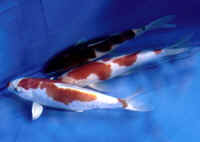
|
|
in which the presenter regaled us with all the reasons
(parasites, poor water quality (Image2: Furuncular condition in
goldfish),
|

|
|
stress from so many sources (Image3: Koi in rough
netting),
|
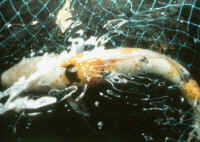
|
|
nutritional deficiencies (Image4: Koran with
HLLE)…
|
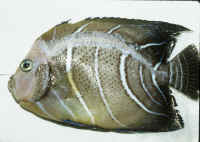
|
why expensive pond fishes should not make it in captivity.
Considering all that can go wrong in the wonderful cascade of electrons
which is life, it is indeed a marvel that there is so much vitality
about.
Disease is "any deviation from a normal or
healthy condition" as a definition will suffice for our
discussion here. As such there are many types of disease, with a few
ways of classifying them. Most prominent of these sources of non-health
are genetic
| (Image: a genetically tweak-mouthed Cirrhilabrus
labouti), |
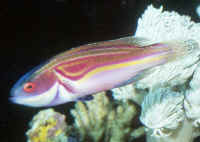
|
Environmental, nutritional, social factors, infectious and parasitic
pathogens. As conscientious aquarists we need to be aware of the root
causes of diseases of our captive charges and do our best to identify,
prevent, and if necessary treat to cure them or reduce their ill
effects.
And there is much aquarists can and should do. Careful, intelligent
livestock selection, properly acclimated and kept in an optimized,
stable environment with its myriad factors, plus excluding and
weakening infectious organisms are the primary aspects of prevention
and control of disease.
|
A very useful model/pictogram detailing the three sets of
factors determining the well being of any system is presented
here (Image6: empty three sets), along with related notes,
specific action to take in successful aquatic husbandry. Like
many early idea-sets, this empirical model is a consequence of
direct observation, tremendous trial and errors, and proof by
utility. I encourage you to think deeply about this. Note the
first sentence in this paragraph; "determine" is used,
not "influence", and well being of any
"system". The "three sets of factors"
elucidated here are lessons beyond a small aquatic microcosm;
they are the same conditions that determine the viability of an
individual, planet or business corporation.
|
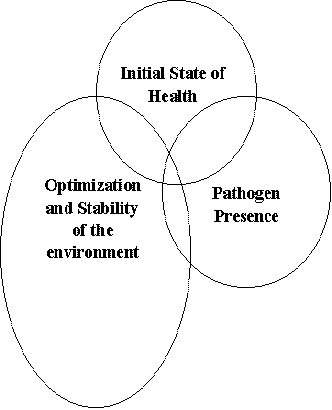
|
Factors Determining Health, The Three Sets:
The three sets of factors determining the health or well being of
any aquatic system are
1. Initial state or condition
2. Suitability of the environment
3. The presence and degree of infectiousness of
disease-causing organisms
All three are separate and yet interdependent upon each other, hence
the interlocking circles of the accompanying pictograph. In the
"real world" of aquarium culture it is ideal to select for
and create the best circumstances for each of the three sets of
factors; though, practically speaking, if two of the three are
realized, livestock losses are greatly minimized. By using this model
in your planning, execution and maintenance of a captive aquatic system
to mentally keep straight the most important aspects of health control
and their relation, you will lose many less organisms.
Let's further describe and expand on these sets of factors.
1. Initial State of Health:
Your livestock's' initial condition is a function of its
genetic heritage coupled with its developmental history.
Similar to cultural discussions of "nature versus nurture" in
our species, how can an individual, population or species become
something more than its genetic makeup? Or discounting DNA, how
important is ontogeny, the development of the one or many of a kind?
Obviously both are crucial, to have the genetic potential to
"fit" an environment, and the "lucky" circumstances
generationally to grow up and reproduce within it.
| How can you assess the initial state of health of
your livestock? By study and observation you know some species
(Images: Moorish idols vs. Heniochus butterflyfishes, source
locations (Images: Choerodon (Tuskfish) from the
Philippines., Australia), sizes of livestock (Images: Too small
(2"), large (8"), about right size (4") Saddle-Back
Butterflies) are hardier/touchier than others. With practice you
will know how to pick out healthy individuals. We'll elaborate
on this later under Aspects of Prevention &
Control. |
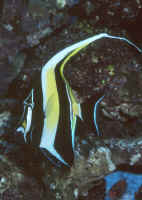
|
2. Suitability of the Environment:
The suitability of the environment incorporates an amazingly large
collection of sub-factors, chemical, physical and biological.
|
A) Chemical/Physical Aspects of Environmental
Stability:
Consider pH, the measure of relative acidity/alkalinity of
aqueous solutions. The pH point, fluctuation and stability
influence almost all biological reactions. A prime example is the
relationship of pH, temperature and ammonia toxicity. Elevated pH
(the higher the worse), with higher temperature, yield situations
of much greater ammonia toxicity. Reciprocally, lowering pH and
temperature alleviate the poisonous affects of ammonia
|
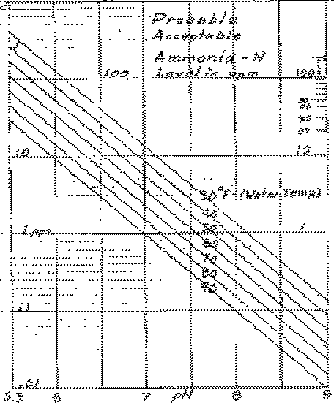
|
ii) Alkaline/acidic reserve is related phenomena,
representing a measure of resistance to change or shift in pH. In small
captive aquatic volumes it is often practical to know how much is
enough such reserve one has. Feeding too much food to too much life can
drive a pH down quickly once the alkaline reserve in a given range is
exhausted. Providing buffering action through supplementation and
maintenance, especially water changes forestall drops into lower
pHs.
iii) Reduction-Oxidation, temperature, carbon dioxide, calcium,
strontium…. Plus many more, could be listed as
chemical/physical phenomena that have high and low limits and a need to
display some semblance of stability to permit life.
iv) Bio-Geo-Chemical Cycling Considerations… nitrogen
in ammonia, nitrite, nitrate. Indeed hundreds of "cycles"
exert their effects (and vice versa) on the life within and around
them. Ammonia poisoning from incomplete establishment of cycling is and
has been the historical number one killer of captive aquatics. It
probably is number two as well, as a contributor to other stresses that
account for mortality.
| v. (Image: plants and gravel) is yet
another aspect of the physical make-up of the non-living
environment that substantially contributes to the health of biota.
How important is the break-up of space, hiding places, dark spots
out of the light to living organisms? Critically so. |
|
vi) Light/lighting; quality, quantity, duration and even
regularity are known to strongly effect the health of aquatic life.
Photosynthesis is obviously impossible without proper illumination
(Images: planted tank, Acropora gemmifera), fishes can be
blinded over time by too much light, notably lions (Image: Pterois
volitans), but practically all livestock benefits from a regular
lighting regimen. Use TIMERS.
B) Biological Aspects of Environmental
Stability:
| Population dynamics includes such ideas as
order of introduction, pecking order and crowding;
all significant contributors to the individuals living in your
system. I have seen many "to the death" fights brought on
by mis-introduction of two too-similar marine angelfishes (Images:
Pomacanthus arcuatus, P. annularis, P.
chrysurus). |
|
Even the act of changing familiarity is demonstrably
stressful to fishes. Often a pond of koi (Image: carp,
Cyprinus carpio) will break down with bacterial infection
(Images: early onset, Furuncular sores) on the placement of a new
individual, though it was apparently "clean" in its
last locale. Observation in the wild and in captivity points to
the high degree of regularity fish life depends on in the living
and non-living components of their environment.
|
|
Sex ratio, and number of individuals (pairs, single, many) are
likewise consequential in captive systems. Think of the fancy
basses of the subfamily Anthiinae (Image: Anthias in RS). How
many males to a harem? One alpha only. The same with communities
of dwarf angels (Image: Flame angel). What happens when the
number one male of a Thalassoma wrasse (Images: T.
lucasanum) group perishes? The highest ranked female becomes
the dominant male within a few weeks. How many Heniochus should
be kept together? The more the merrier.
|
C) Foods/Feeding as Aspects of Environmental
Stability:
The types, format, quantity, food value, frequency and method of
delivery are all important parts of the behavior and nutrition of
feeding. Think how stressful it is to you to not get the foods you
prefer properly prepared and presented, at a regular interval,
nutritionally complete, in a "conducively" pleasant consuming
environment.
D) Almost Infinity:
How many more environmental criteria can you think of? Obviously
this is not an exhaustive list of contributing environmental factors,
such a counting would be vast indeed, detailing all interactions,
chemical, physical, and biological, conscious and not that each
organism has with their world.
3. Presence and Degree of Pathogenicity of
Disease-Causing Organisms
Absolutely no infection or parasitic disease can occur without its
causative biological mechanism. Where would black spot disease (Images:
Paravortex, Yellow Tang) come from if not imported into a system
on Yellow Tang host? Certainly not from thin air. Specific
pathogen free livestock is a dream that is near impossible to attain,
but much can and should be done to "knock off" the majority
of external parasites and weaken the rest.
|
Consideration of biological agent disease principally involves:
The number of parasitic and infectious species,
Their respective population, or load of agents per
host, and
Their degree of infectiousness, or
hyperinfectivity.
|
|
Having more types and numbers of parasitic and/or infectious
(bacterial, fungal, viral (Image: Lymphocystis on a Queen Angel)
species on a host is directly positively correlated with a loss
of vitality and increased mortality. Less well elucidated is the
synergism of hyper-infection in aquarium livestock. Once a
biological agent problem "gets going" our subjective
evaluation of the condition switches from "chronic" to
"acute". An excellent though sad example is the
occasional pandemic of "ana aki" (Japanese), "hole
in the side" or furunculosis sores (Image: koi with ventral
sore) associated with Aeromonas bacteria. In
"good" years, this condition appears as a
non-debilitating disfiguring open wound on one or a few coldwater
fishes in a pond. In bad years, many or all piscine livestock die
within a few days to weeks with massive internal bleeding.
|
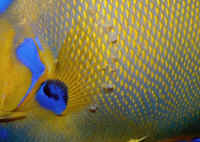 |
 |
What triggers this change in infectiousness? Is it a genetic nuance
such as this and that new strain of influenzas in humans? Is it somehow
related to that elusive sylph "water quality", the polyglot
which is "nutrition"? Poor development or a result of
built-in difficulties pre-Diaspora from the livestock's' common
origins, i.e. a genetic "time-bomb"?
Do you start to see the usefulness of this "Three sets of
factors" model? All three of these sets of factors are intimately
tied together in outright determining the health of your livestock. By
investigating, testing, and acting on these parameters you can strongly
tilt the balance of health/disease in your livestock's favor.
Let's carry this discussion along to consider specifically what
you can do to optimize each of these three sets of factors determining
livestock health in terms of
|
Aspects of Prevention & Control:
Doing the best you can for your aquatic charges in two of the
three sets of factors listed will get you by in many if not most
cases. The conscientious aquarist will shoot for all three. This
lofty goal is within your grasp. Here is an itemization of
specific actions for your edification.
|
 |
1. Initial State of Health:
Selection; a/the secret of keeping healthy livestock is no mystery
at all. You want to start with the healthiest, most likely to
flourish-in-your-care individual/s. This can be a little tricky, as
wild stocks purposely disguise any infirmity (lest predators seeking
the easiest prey consume them). How can you tell how roughly the
handling and shipping has been?
|
Appearance, behavior: Knowledge is paramount here. What
does a healthy individual look like? How does it behave? Should
it be "out and about" or is skulking in the corner ala
the basses like (Images: Liopropoma, Epinephelus merra)
… natural? Is the animal curious about its surroundings,
your presence? Is its bright coloring a warning sign that
it's been cyanided?
|
|
Source: can be extremely important; the regal angel,
Pygoplites diacanthus rarely lives collected out of the
Indo-Pacific ; ones from the Red Sea are quite hardy (Images:
from both). Likewise, here again the example of the wrasse called
the Harlequin Tuskfish. It's tough when it hails from
Australia and frail from the Philippines. Ask your dealer, or
better still check their manifest/invoice for the source of your
livestock. Captive bred and preferred-places of origin are better
than cheap, sick and soon-dead livestock.
|
Feeding: is it? Though not foolproof, the fact that a captive
is feeding is a strong indication of its viability. Sufficiently
cyanided organisms rarely eat, or if they do, perish soon afterward. A
feeding response is indicative of further adaptive behavior.
Time on Hand: how long has the specimen been there? The vast
majority (99%+) of marines and more than half of freshwater livestock
is wild-caught. Generally there is a matter of days to a couple of
weeks time between its capture and your seeing it. When do most losses
occur? Right around this time, dropping off rapidly as time goes on.
When in doubt as to a purchase, wait. Which brings us to
Purchasing Techniques:
|
a. Assessing the store, personnel: how much they
know, care and practice contributes/detracts from the health of
their livestock. How do they rate? Would you put your fishes,
non-fishes in their systems? If not, then why buy from them?
(Image: Wet Pets LFS)
|
|
b. The deposit & waiting game: especially for expensive
and questionable buys, putting earnest money down to "hold" a
purchase for a few days to a couple of weeks should work out as an
advantage to everyone. You for the possibility of avoiding
"anomalous loss", and the retailer for the same, plus
"free advertising" of the livestock for future
purchasers.
2. Suitability of the Environment:
Here the key words are Optimized and Stabilized; utilizing
a
|
System as large as possible,
Properly set-up
Testing/Monitoring your water quality.
Utilizing appropriate Decoration/Habitat for your
livestock beyond/beside aesthetic considerations, and
carefully
|
|
Observing Your Livestock
Per their health, interaction on acclimation,
introduction, feeding and
Routine maintenance, especially frequent, partial water
changes.
|
|
Patience & Moderation (Yours): Never to discount
the human factor, you've got to take your time in
Initial set-up. Planning, assembling, testing all
gear.
Stocking. Per a scheme built around a central theme,
biotope, and compatible livestock.
Feeding. Varied foods, assuring all are getting
nutrified, not just ingesting.
Treatments. If/when necessary, which brings us to
|
3. Presence and Degree of Pathogenicity of
Disease-Causing Organisms:
Once again:
|
Knowledge and intelligence on your part are requisite.
What is the root cause of your apparent difficulty? Are you
really sure you are witnessing a biological disease agent, and
not just a poor water-quality, incomplete nutrition, anti-social
reaction? How are you going to be aware of what to do? Reading
(Image48: Baensch books) on the subjects, discourse with other
hobbyists, attending shows, talks, videos.
|
| Quarantine/Dips-baths. All new livestock
should be kept apart from established stock, out of the
main-display system for a good two weeks. For collectors,
transhippers, wholesalers at least routine dipping, preventative
baths should be administered to fishes and corals (Images49,50:
brown jelly infection of coral, cut marks on a Hemitaurichthys). If
this advice is followed, medications should only be administered
within a |
| Treatment Tank. Were all this so, our hobby
interest would be ten times the size and vigor, as many fewer
organisms would be unnecessarily lost, and the hobbyist discouraged
to the point of dropping out. A separate tank with filtration,
heating, a cover should be available to run in tandem with your
main-display tank(s). |
|
Treatments themselves are/should be a last resort. Many
are quite toxic and you would be hard-pressed to find a few
retailers that would agree that more livestock is killed by
disease than by treatment. You are treating the whole system when
you administer a chemical to your livestock; even with medicated
foods (Image51: Making medicated food). There is an order of
preference in treatment modes:
Biological, as in the use of cleaner shrimps and gobies
(Images52,53: shrimp & goby) in saltwater systems.
Environmental manipulation, such as lowering specific
gravity (or adding salt in freshwater systems), changing
lighting, temperature… can be done to favor the hosts (your
livestock) and disfavor their disease agents.
Chemical Treatments must involve consideration of
efficacy: effectiveness, specificity, safety, and
cost-effectiveness. As you would do with your own health or those
of other humans entrusted in your care, investigate potential
treatments before administration. Don't simply poor such and
such in on one persons say so. Most such treatments do little
good, indeed, more often cause more harm than good (Images:
Dropsical goldfish, eye "fungus", Lymphocystis).
|
|
Per the model presented here, REVIEW the three principal sets
of factors that determine the health of all systems and their
sub-sets and make a concerted, coordinated effort to disclose the
root causes of a problem. Seek to cure or ameliorate those
conditions, only lastly resorting to outright chemical
treatments; and then only knowing what you're treating for
and how.
|
Bibliography/Further Reading:
Bassleer Biofish (for
books, videos on disease)
http://www.aquaworldnet.com/awmag/diseases.htm
Fenner, Bob & Dave Huie. 1987. A livestock treatment system. FAMA
1/87.
Fenner, Bob. 1989. Parasitic diseases of cultured fishes: methods of
their prevention and treatment. FAMA 10/89
Fenner, Bob 1992. Copper poisoning. FAMA 3/92.
Fenner, Bob. 1993. Chlorine, chloramine poisoning; or, how I treat
my tapwater. FAMA 3/93.
Fenner, Bob 1993. An argument against "feeder" goldfish.
FAMA 11/93.
Fenner, Robert 1998. Organism selection for the saltwater aquarist,
pt.s 1-4. TFH 5-8/98.
Fenner, Robert M. 1998. The Conscientious Marine Aquarist; A
Commonsense Handbook for Successful Saltwater Hobbyists. Microcosm, VT.
432pp.
Guerri, Elmer A. 1998. It's the stress; using the techniques of
professional aquarists. AFM 3,4/98.
Halver, J.E. (ed.). 1989. Fish Nutrition. Academic Press, London.
798pp.
Hiatt, Snake. 1998. Major, macro, micronutrients. TFH 7/98
Johnson, Erik L. 1993. The insidious threat of stray voltage. TFH
7/93.
Noga, Edward J. 1996. Fish Disease, Diagnosis and Treatment.
Mosby-Year Book Inc., St. Louis. 367pp.
Steffens, W. 1989. Principles of Fish Nutrition. Ellis Horwood,
Chichester, UK. 384pp.
Watson, Thomas T. 1983. An ounce of prevention. TFH 9/83.

